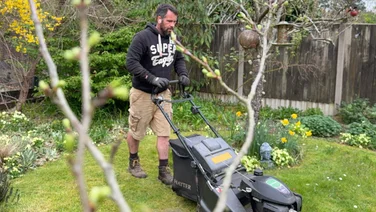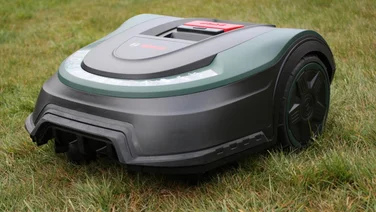To help us provide you with free impartial advice, we may earn a commission if you buy through links on our site. Learn more

Everyone’s lawn needs a haircut now and again. But while it’s usually easy to spot when your turf has become a little unruly, it’s harder to judge how short to cut your grass. Take too much off and you could leave every blade exposed to drought and disease, but be too conservative and you could quickly go from garden to jungle. Either way, it won’t be pretty.
So before you adjust the height setting on your best lawn mower (or trust the task to a robot lawn mower), we recommend you check out our advice from three lawn care experts – Paul Hicks, Product and Marketing Manager at Stihl GB, Bowood‘s Head Gardener, David Glass and Jonathan Snowball, Head of Professional Development UK at Husqvarna.
Why does it matter how short you cut your grass?
“Regular mowing is important to promote dense growth, keeping your grass lush and green,” explains Paul Hicks. “If your grass is too long it could look untidy and will be susceptible to weeds, but if it’s cut too short it won’t be able to protect your soil from diseases such as leaf spot.” The latter could leave you with bald spots that will need to be patched up with grass seed.
“The height at which you cut your lawn plays a crucial role in its overall health and appearance,” agrees David Glass at Bowood. “During the winter months, I’d suggest that you keep your lawn slightly longer to protect the grass from frosts, while in the summer, cut it shorter for a neater finish.”
“You should be able to adjust the cutting height of most lawn mowers quite easily, which means you can always be sure to mow your lawn to the precise height you want so it’s neat, tidy and healthy,” adds Paul.
Both Stihl and Worx lawn mowers typically offer five or six different cutting heights between 25mm and 75mm (that’s around 1 to 3 inches), but this can vary slightly depending on the model. Bosch lawn mowers generally offer cutting heights of 25mm to 80mm, but again there can be variations depending on the model.

What’s the “one-third rule” for grass cutting?
This simple rule will ensure you don’t damage your grass in the long term by trimming too much off at any one time. “At any point in the season, following the ‘one-third rule’ can help maintain a consistent level of health in your lawn,” says Husqvarna’s Jonathan Snowball. “Each time you cut the lawn you should remember to never remove more than one-third of the grass blade.”
“If you are mowing your lawn frequently then it is easier to maintain the one-third rule,” Jonathan adds. “Usually, cutting once per week at the same height each week can achieve this. But if your grass is heavily overgrown then consider lowering the cutting height in stages over a two-to-three-week period to avoid causing too much stress on the grass.”
“Husqvarna robotic lawn mowers work on a principle of cutting a little and often,” he explains. “By cutting every day we only remove the tip of the grass blade, resulting in very little stress on the grass blade, keeping the lawn in a very healthy condition.”

How short should your first cut of the season be?
“Avoid the temptation to immediately cut the grass at a low cutting height,” says Jonathan Snowball. “It may be tempting to drop the cutting height low for the first cut to get a nice finish, however, doing this can put stress on the grass and make it more vulnerable to disease, frost and pests.”
Instead, follow the one-third rule, so if your grass has grown to a height of 90mm, you’d want to take a maximum of 30mm off on your first cut. That would mean setting the cutting height to 60mm.
How short to cut your lawn over the summer
“As the growing season begins in May, gradually reduce the cutting height to match the lawn’s more active growth, as extreme changes can damage the grass and weaken the overall lawn. Begin reducing the height as growth picksup in spring and continue reducing it gradually as summer progresses,” advises David Glass. “However, during periods of drought or when the grass appears stressed, raise the cutting height again to reduce strain on the lawn.”
“The ideal length for your lawn will depend on what type of grass you have and what it’s used for,” says Paul Hicks. “As a general rule, I’d advise keeping your lawn around 3-5cm. When temperatures rise in the summer months, I’d recommend keeping your lawn around 5cm long, which will help to keep the soil underneath cool and help prevent water stress and lawn scorch.” However, Paul goes on to break down the perfect lawn length for differing purposes:
For a smart, ornamental lawn
“For ornamental lawns, a length of 2-3 cm is ideal to achieve an even, velvety look,” says Paul. “If your ornamental lawn doesn’t get walked on, you could take it even shorter than this. However, the higher the temperature, the longer the grass should be – during the summer months when it’s hot and dry, you should keep your ornamental lawn at around 5 cm to prevent damage.”

If your lawn doubles as the kids’ football pitch or putting greet
“If your kids regularly play football on your grass, or you’re using your lawn as a mini putting green, I’d advise keeping it at between 2.5-3cm,” says Paul. “This shorter length will help to create a smooth surface which means balls will roll better and be easier to aim. An even surface will also mean less risk of injury!”
If your lawn is particularly shaded
“If your lawn is in a shady area, it’s best to keep it a little longer at around 5-6 cm high all year round,” explains Paul. “The extra surface area of the grass will mean it can absorb more essential sunlight.”
To encourage wildlife, such as birds and butterflies
“If you prefer a more natural, meadow-style lawn, keep the grass longer to allow ground-level plants to thrive,” suggests David Glass. “This approach encourages biodiversity, supporting pollinators such as bees and butterflies.”

Westland Lawn Meadow Wildflower & Lawn Seed Mix, £15 (covers 40 sq m), Ocado
If you're considering a longer lawn, this pet and child friendly meadow mix is more likely to attract beneficial insects to your garden, such as bees, butterflies, ladybirds, hoverflies and lacewings. It's also a source of food and essential oils for birdlife. After sowing, you can expect flowers to appear within two months.
How short to cut your lawn in winter
When you’re ready to overwinter your lawn, you should stop cutting the grass altogether. “When it comes to the winter months, once the first frost of the season comes you should stop mowing – during the coldest months, your lawn needs to rest,” says Paul Hicks. “I’d also advise you to avoid walking on your lawn during the winter months to prevent damaging the grass when it is at its most delicate.”
Your “last cut” of the season will depend on where you live. If you are in the very south of the UK, where the weather is particularly mild. Otherwise this will fall some time in October, ideally in the week before the first frosts are forecast.







